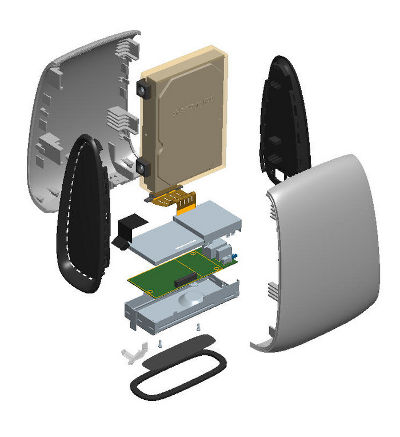| Space Monkey - A Personal Distributed Cloud |
| Written by Harry Fairhead | |||
| Friday, 31 May 2013 | |||
|
The problem with the cloud is that it tends to be centralized and remote. Space Monkey has just secured $350,000 in Kickstarter funding to make the cloud personal by selling commodity boxes to end users. The basic idea proposed by Space Monkey isn't crazy. Create a box, the Space Monkey box, with 2TBytes of storage in it, connect it to the local network and use it as if it was DropBox, Google Drive or SkyDrive. There is nothing new in this - you have been able to buy low-cost NAS systems that do exactly this for a long time. The key difference is that the user only has access to half of the storage, i.e. 1TByte. The other 1TByte is used by a network of Space Monkey boxes to back up and replicate your data. "Once data is in your Space Monkey, the device continues working for you in the background. It’s in charge of encrypting your files and making redundant, secure copies of them to store in the network. You don’t have to leave your desktop uploading data overnight, or your laptop open waiting for a transfer - that’s Space Monkey’s job." Yes Space Monkey boxes work together to build a distributed datacenter.
You can access your data via the web, mobile phone or from any location you can connect to the internet. Of course, access speeds are slower over the internet but at least you get high speed access when you are on the same local network. The real point of the system is the distributed backup. It is claimed that if you device fails, or is stolen, all you have to do is get a new device and it rebuilds itself. It is claimed that half of the units holding fragments of your data would have to be destroyed before you lost your data. You can think of it as a sort of distributed, fault-tolerant, RAID array. If you are worried about security, it is worth knowing that the data is stored in encrypted form and the fragments that are sent to other Space Monkey boxes are also encrypted. Your box also monitors the health and accessibility of the distributed fragments and it it finds there are too few it regenerates the missing pieces and restores them.
A more serious problem is the loading on your internet connection. It is clear that sharing the data between units and accessing the data remotely is going to be contributing to any ISP data cap. If you use a true cloud system then accessing the data from a remote location doesn't make use of your internet connection.A bigger problem is that remote access might be slower because of the slower upload speeds usually offered by ADSL connections. It is claimed that the Space Monkey can use multiple connections to different locations which seems to suggest that it can access the distributed copy of a file something like BitTorrent. If so then this is very sophisticated.
Currently there are working devices out across the USA being tested. There are desktop clients for OS X, Windows and Linux and mobile clients for Android in internal test. There is also a Web client. There is clearly also a lot of scope for software improvements and the boxes auto-update over the network to the latest version. You don't actually buy a Space Monkey - you rent it at $10 for 1Tbyte per month which compared to cloud based options is very cheap. It remains to be seen how well the system will scale and how much of a hit it will be with consumers, but it is another example of simple hardware and clever software attempting to breakup the huge centralized server farms of the cloud. The personal cloud is a good idea we just have to figure out the software to make it work.
More Information
Related ArticlesWhy The End User Cloud Is Dead
To be informed about new articles on I Programmer, install the I Programmer Toolbar, subscribe to the RSS feed, follow us on, Twitter, Facebook, Google+ or Linkedin, or sign up for our weekly newsletter.
Comments
or email your comment to: comments@i-programmer.info
|
|||
| Last Updated ( Saturday, 01 June 2013 ) |


